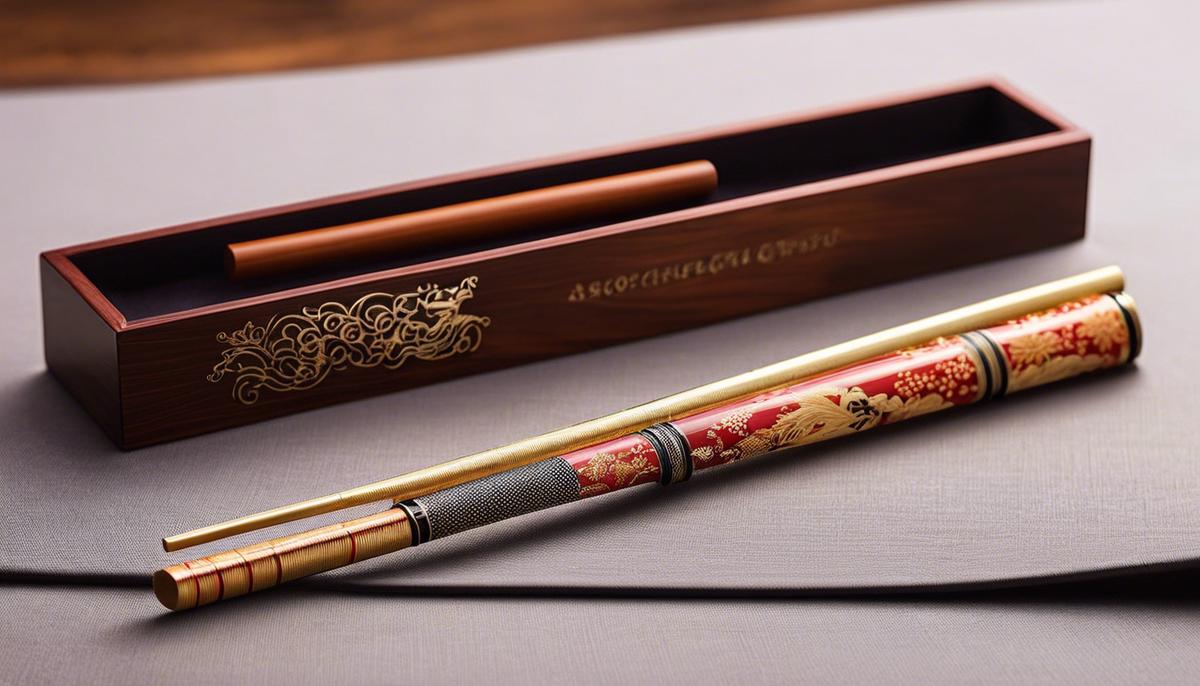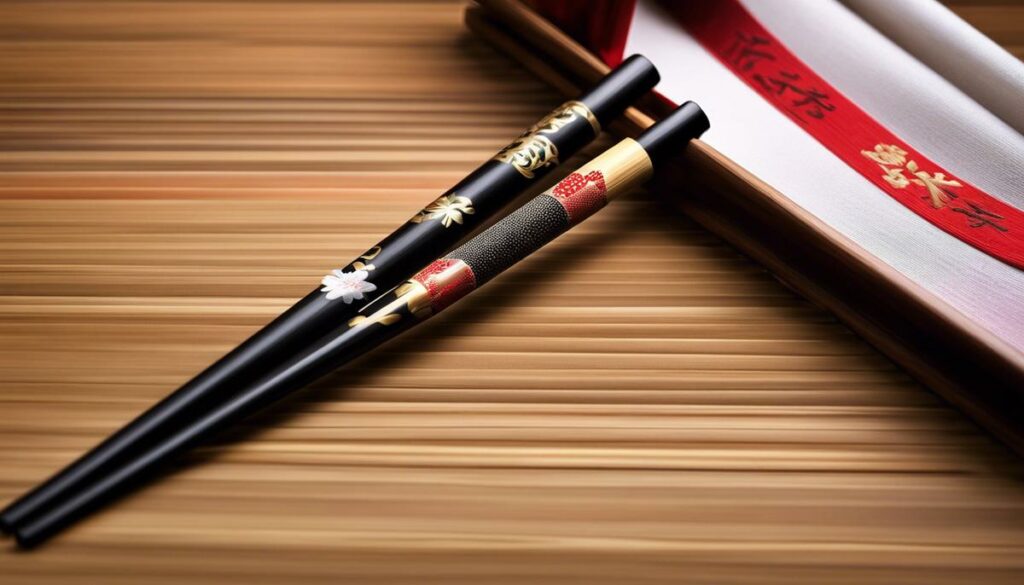The Japanese chopsticks, also known as hashi, are more than just a useful utensil to enjoy sushi. Their use is deeply rooted in the nervous system of Japanese culture and has a rich history and significance that is often overlooked by non-Japanese. Tracing their origins, exploring their possible uses and shedding light on their significance in society, we will dive into this fascinating world of chopsticks. Finally, our journey ends with an in-depth look at how to choose the right chopsticks, taking into account the material, length, shape, and embellishment. It’s much more than just ingesting food – it’s the delicate interplay of culture, etiquette, history and craftsmanship.
History of Japanese chopsticks
When we look to the West, many people often think of knives and forks as traditional cutlery. Well, if we turn to the east, chopsticks are the tool of choice, especially in Japan. In fact, the history of Japanese chopsticks (hashi) is longer and more complicated than most people would suspect.
Chopstick culture began in China, not Japan, and later spread to Korea and Japan. The earliest evidence of the use of chopsticks dates back to 1200 BC in China. Over the centuries, these tools have been made from a variety of materials, from bamboo and wood to bone and bronze to today’s modern plastics.
It was during the Yayoi period (300 BC – 300 AD) that chopstick culture made its way to Japan, probably via Korea. Originally, they were only used for sacred ceremonies, but later they found their way into everyday life. Over time, Japanese chopsticks began to differ from their Chinese and Korean counterparts. They became sharper and longer, which allowed for a gentle and precise way of eating.
Over the years, Japanese chopsticks evolved to encompass not only mere functionality, but also aesthetics. Today, the city of Obama in Fukui Prefecture is home to Japan’s most famous chopstick manufacturers. They produce around 80% of the country’s chopsticks and are known for their exquisitely crafted designs and the quality of their craftsmanship.
Throughout Japan, it is polite to follow certain rules when using chopsticks. These include taboos such as piercing food, passing chopsticks to chopsticks, and keeping chopsticks upright in rice – all of which are actually actions performed during funeral rituals.
Modern dinnerware may seem new and shiny compared to ancient traditions, but the history and culture of chopsticks in Japan remains firmly entrenched. These small devices, as simple as they may be, are expressions of a deep-rooted culture of respect and precision that is at the heart of Japanese society.

The correct handling of chopsticks
The right way to use chopsticks
Now that we’ve covered the historical and cultural background of chopsticks, let’s get down to the practice. It is imperative how to use chopsticks correctly to honor the true spirit of the chopstick tradition.
Hold a chopstick in the middle with the chopstick resting on your thumb and little finger. The other stick is supported by the middle finger and controlled by the thumb and index finger. It is important that the upper rod is movable while the lower rod remains stable. The top rod is used to move and divide food.
It may be difficult for the beginner, but don’t worry, it just takes a little practice and patience. It is also important to mention that chopsticks should never be put down while sitting or eating, nor should they be put in a pot or bowl, as this is considered extremely rude.
No noise is also desired when handling chopsticks. Do not stir or tap the plate. It is considered rude and leads to an unpleasant sound experience for everyone who is present.
Stylish food with chopsticks
Well, some would say that dining table etiquette and style is a matter of personal preference, and in many ways this is true. But keep in mind that eating with chopsticks is also a form of communication. It shows respect for your culture and your host. It’s the fine balance between respectfully enjoying your meal and acknowledging the culture and work that goes into each dish.
If you are in a place where chopsticks are used, show your respect and enhance your eating experience by keeping these principles in mind. It’s not just a matter of practicality, it’s also a way to add a touch of class and sophistication to your lifestyle.
By showing that you pay attention to these small details, you can feel your personality and your appreciation for the. And it opens up a whole new world of culinary possibilities, as chopsticks really allow you to enjoy every bite.
Remember that aesthetics and style go hand in hand, and the same goes for food. So, take the time to learn and enjoy this art, and you’re sure to appreciate your culinary journey even more. Because just like fashion, the use of chopsticks has its own charm and beauty.
Enjoy your meal!

Choosing the right chopsticks
Now that we’ve delved deep into the rich history and culture of Japanese chopsticks, it’s time to talk about choosing the right pair. As with any other item that is used on a daily basis, it’s important to feel comfortable with your chopsticks. However, it is not only comfort that plays a role, but also respect for this millennia-old culture.
You may be wondering what the best materials are. Well, you can find chopsticks made of different materials such as bamboo, wood, metal, and plastic. Bamboo and untreated wood are very popular because they are lightweight and easy to handle. In addition, they do not absorb the heat of hot food. Metal chopsticks, on the other hand, are durable and hygienic, but pass on the heat of the meal. Plastic sticks are easy to clean, making them ideal for everyday use.
There are also different forms of chopsticks. For beginners, round and thick chopsticks are less slippery and therefore easier to handle. If you want to improve your handling, try chopsticks with a square or octagonal cross-section. These promote precision and control. The length of the rods should also be taken into account. Typical Japanese chopsticks are about 22-25cm long.
Decoration and design can further enhance the experience with chopsticks. Choose patterns that match your personal style, showing your sense of aesthetics and respect for Asian culture. Embossed or painted motifs, shiny layers of varnish, or even patterns engraved in gold or silver can make your meal an unforgettable experience.
Don’t forget to consider your own tastes and preferences. There is no right or wrong. The most important thing is that you feel comfortable with your chopsticks and can enjoy the meal.
Their lifestyle is reflected in the smallest details, even in the choice of chopsticks. With these tips, you can not only make your meals more enjoyable, but also add a touch of sophistication and class. Let your chopsticks become a part of your story and personality and experience how they enrich your eating experience.

The role of chopsticks in today’s society
The chopsticks have gained a remarkable place in the globalized fashion and lifestyle world. They are not just a simple tool for eating, but rather a symbol of aesthetics, culture and respect.
First, let’s look at the different materials for chopsticks. Each material has clearly defined advantages and disadvantages. Bamboo and wood are eco-friendly and give a warm, organic atmosphere. Metal is hygienic, durable and offers a unique sensory experience. Plastic is inexpensive, easy to clean, and offers endless design possibilities.
The shape of the chopsticks also plays a significant role. Round, thick, square, square – each shape has an individual effect on the user. While some prefer the smooth touch of round chopsticks, others like the firm grip of square ones. It’s a matter of personal taste and comfort.
The length of the chopsticks also deserves attention. Different lengths are suitable for different dishes and types of application. While longer chopsticks are ideal for cooking or sharing dishes, some often prefer the shorter ones for personal consumption.
The décor and design of chopsticks is another aspect that can reflect your personality and style. The embellishments, the color, even the material can tell a story, your story. Don’t be afraid to get creative.
An instructive fact is that there is no right or wrong when it comes to chopsticks. As long as you’re comfortable with them, you’re doing the right thing.
Now, let’s take a look at incorporating chopsticks into your lifestyle. They are much more than just a utensil. They add a special sophistication and class to meals.
In addition, chopsticks allow you to reflect your personal history and personality. Maybe you have a special connection to Japan, like the Zen aesthetic, or simply appreciate the artistry and patience needed when handling chopsticks.
In conclusion, chopsticks can enrich the dining experience. They bring nuance and sophistication to the enjoyment of food. They are a powerful symbol of respect for the culture and traditions they represent. And they encourage careful, conscious interaction with food.

By delving into the world of chopsticks, we have opened our eyes to the beauty and meaning of this everyday object. We’ve seen them grow from their beginnings as a practical tool to a central part of Japanese culture, while reflecting their importance in today’s society and future trends. Although chopsticks may seem simple to use, the complexity of their selection and their important place in Japanese culture suggest that they are much more. With the knowledge and insight we now possess, we are better equipped to appreciate the art and aesthetics of these simple yet meaningful cutlery and enjoy not just the food but the entire experience at the next sushi dinner.


